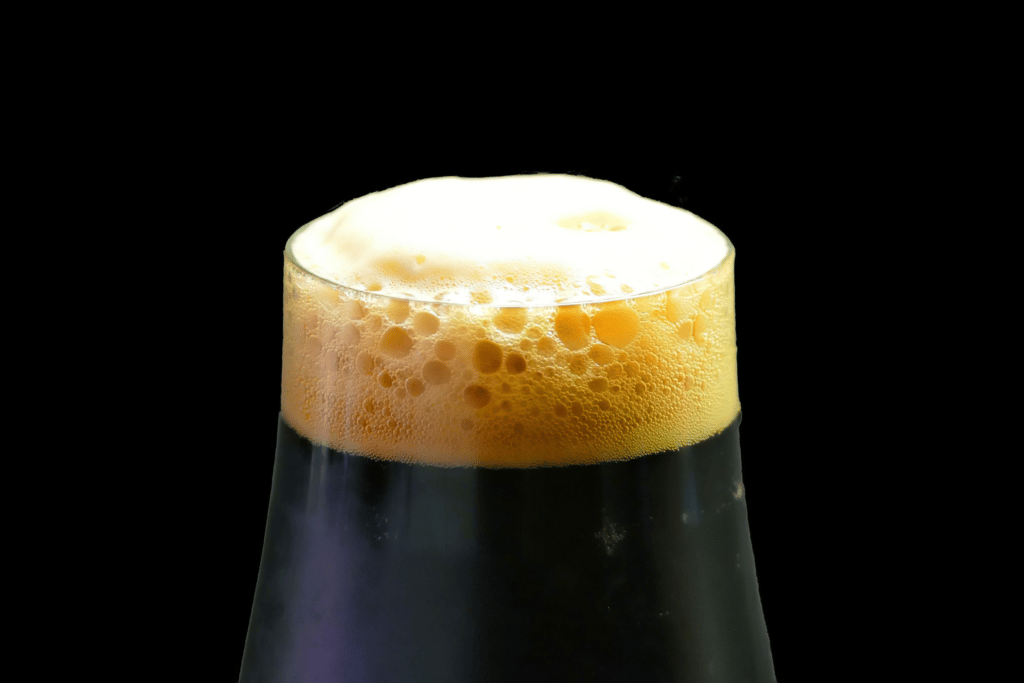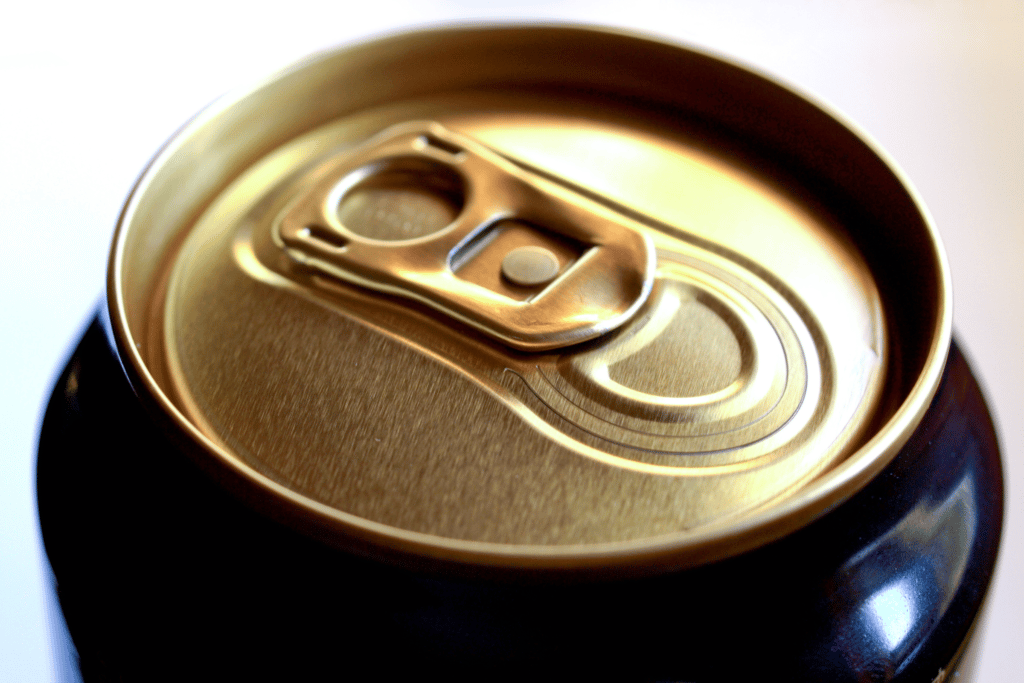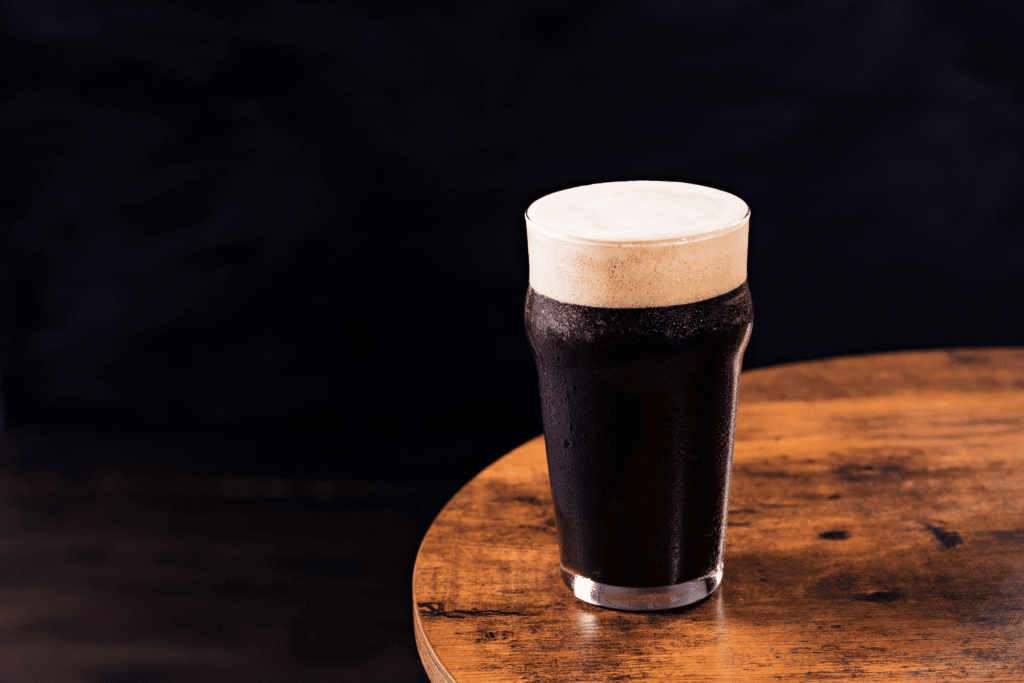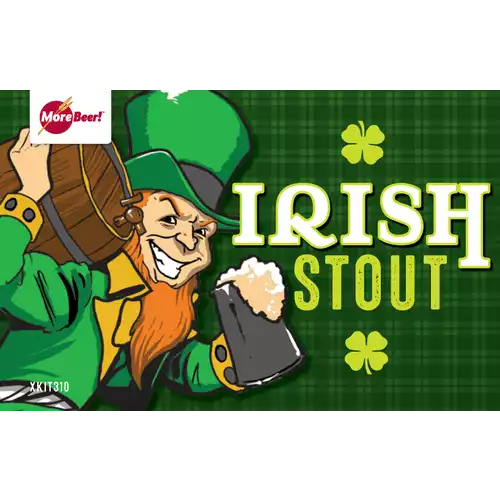The Irish Stout is recognized worldwide for beers like Guinness Extra Stout and Guinness Draught. If you’re interested in Irish Stout recipes and learning how to brew one yourself, the process is simple and painless.
Brew a delicious Irish Stout by using British ingredients. East Kent Golding and Fuggle hops are the most popular choice for this style. British yeast strains that offer less fruity esters are the best choice. Roasted and flaked barley are the key ingredients. Pale malt should be used as the base grain, resulting in a dry, roasty, and slightly bitter beer.
Keep reading for in-depth information on how to brew an Irish Stout.
Topics We Cover
What is an Irish Stout?
The Irish Stout comes from a long line of London history and a very specific beer style that was eventually turned on its head to become a more refined version housing many of the same characteristics as its English predecessors.
Irish Stouts use British malts and hops (most commonly East Kent Golding from Kent, England). They use ale yeast for a full body and flavor, accompanied by subtle fruity esters overtaken by malt aroma and hop bitterness.
Irish Stouts use unmalted roasted barley and are often nitrogenated. These two key factors lend both the roasty flavor and silkiness for which the style is known. Irish Stouts are also characterized by their black color, off-white head, medium to high hop bitterness, and creamy mouthfeel.
- Color – Black
- Common flavor – Coffee-like roastiness with medium hop bitterness
- Aroma – Roasted barley with coffee and sometimes caramel
- Mouthfeel – Silky smooth, soft and mouth-coating
- IBUs (Bitterness) – 30-40
- ABV – 3.8-5%

History of the Irish Stout
The Irish Stout is a wee lad of a style that has transformed transformation over the few hundred years since it was first drunk under a different style. Stouts weren’t always called stouts, and Irish Stouts used to be called porters.
Before Daniel Wheeler invented a roaster in 1817 to produce what is still known as Black Patent Malt, these beers were merely porters with an extra, distinct smokiness. It wasn’t until the dark and bitter Black Patent Malt came along that this London-style beer got the gratification it deserved.
While London brewers continued using brown malt to brew porters, overlooking Wheeler’s invention, Irish brewers took the new malt and ran with it. By the mid-1800s, Irish brewers invented a new beer style different from the London Porter.
In 1851, Irish brewers started using Daniel Wheeler’s Black Patent Malt to brew porters. The smokey flavors that were characteristic of porters using roasted brown malt subsided and evolved into the roasty but dry, bitter, silky and sessionable style we know today as Irish Stouts.
The Free Mash Tun Act in 1880 made it possible and practical for brewers to use unmalted roasted barley in the stouts instead of malted grains. The unmalted barley is what’s used in this style today.

Popular commercial Irish Stouts
Here are a few great examples of the Irish Stout style for you to try:
- Guinness Extra Stout – Roasted malt and coffee flavor and aroma complemented by a sharp bitterness. Dry with a quick finish.
- North Coast Old #38 – Dark roasted malt flavor and aroma with a smooth and firm body. Nearly pitch-black body with a light brown head.
- Breckenridge Brewery Nitro Irish Stout – Brewed with roasted Irish barley. Rich malt flavor and medium bitterness.
- Rhinegeist Luck – Notes of chocolate and raisins with hints of coffee. Full body with a dry and quick finish.
Popular Irish Stout recipe kits (all-grain or extract)
Here it is, a Dry Stout in the style of Guinness.
Flaked Barley helps to provide all the protein that is needed to produce that wonderfully creamy head. 43 IBU of bitterness compliments the dryness of the Roasted Barley to produce authentic Irish Dry Stout.
How to brew an Irish Stout
Now that you know more about Irish Stouts, let’s get into the nitty-gritty of how to make one. I will go step by step to dive into the ingredients and how they are used on brew day.
If you’re wondering how long it takes to brew an Irish Stout before you begin, then look no further. The entire process from brew day to tasting day will take 2-4 weeks. This can vary depending on whether you keg or bottle.
Recipe and ingredients
Before you can start brewing an Irish Stout, you will need to collect the proper ingredients. This style is pretty straightforward with a small amount of room for experimentation. Below are some tips and guidelines to get you started, but feel free to investigate any possible substitutions or creative implementations for ingredients or methods.
Water profile
A good water profile for an Irish Stout has a low pH and low mineral content. The most efficient way to reach a desired water profile is to start with RO water and add minerals as needed. Irish Stouts do well with high sulfate levels.
Sulfate enables dryness, crispness and hoppiness in beer. For an Irish Stout, adding Gypsum will elevate sulfate levels to enhance these characteristics.
Base grains
Grains are the difference-makers in many beer styles, including the Irish Stout. It’s important to use high-quality base grains.
Irish Stouts use British Pale Ale malt as the base grain. British Pale Malt has a rich but subtle flavor giving the beer initial malty and caramel flavors and aromas that are then masked by roasted barley.
Sweeter grains like Vienna, Munich, Caramel and dextrin malts should be avoided or used sparingly when brewing an Irish Stout. Stick to pale malts and you’ll have a sufficient base grain.
Generally, an Irish Stout’s flavor comes from specialty grains.
Specialty grains or other additions
Dark beers like stouts get a lot of their flavor and color from specialty grains.
Irish Stouts use specialty grains to obtain their roasty flavor and brown-black appearance. Flaked and roasted barley are the two specialty grains used in Irish Stouts. Oftentimes they will only use roasted barley alongside a pale base grain. The roasted barley gives Irish Stouts their dryness and sharp bitterness.
Another specialty grain that benefits Irish Stouts is Black Patent Malt. These specialty grains usually make up at least 10% of the grain bill.
Hops
Hops play a big role in any beer, including Irish Stouts. They’re used to balance sweetness and add bitterness and flavor.
Irish Stouts use East Kent Golding hops mostly for flavor and aroma. These English hops give Irish Stouts earthy undertones that complement the roasted coffee and chocolate flavors brought on by roasted barley.
The most important aspect of hop selection is choosing varieties that complement each other. As you’ll see below, bittering hops have more to do with the bitterness of a beer whereas flavor and aroma hops are more responsible for the taste and smell.
Bittering
Bittering hops are used to add bitterness to beer. They’re added at the beginning of the boil allowing ample time for isomerization to occur. At the same time, the aromas of these hops are boiled away and the wort is left with a strong bitterness.
Because bittering hops don’t add much flavor or aroma to beer, it’s best to choose ones that have a high alpha acid content to maximize bittering efficiency during brewing. Although bittering hops aren’t responsible for flavoring, too much can cause the beer to taste vegetal.
Here are some good bittering hops to use for an Irish Stout.
| Name | Purpose | Alpha Acid % |
| East Kent Golding | Bittering + Aroma | 5-6% |
| Chinook | Bittering + Aroma | 12-14% |
| Cascade | Bittering + Aroma | 4.5-8.9% |
Aroma and Flavor
Aroma and flavor hops are used for exactly that – aroma and flavor attributes.
Aroma and flavor hops are added late in the boil, usually past the halfway mark. The more time they’re in the boil, the less flavor and aroma they give off. For Irish Stouts, English hop varieties like East Kent Golding or Fuggle. Hop aromas in this style should be low to nonexistent.
These hops also require greater selectivity. Not all flavor and aroma hops go together and the wrong combinations can create undesired flavors. Try to use hops that complement each other.
In styles where hops take a backseat, it’s common to use one strain of hop so the flavor is manageable. Note that all hops give off at least some bitterness despite when they’re added to the boil.
| Name | Flavor/Aroma | Alpha Acid % |
| East Kent Golding | Earthy, spicy, lavender | 5-6% |
| Fuggle | Earthy, floral | 2.4-6.1% |
| Willamette | Spicy, floral, fruity | 4-6% |
| Cascade | Citrus (grapefruit), floral | 4.5-8.9% |
Yeast
Yeast plays various roles in brewing. As such, different beer styles require different yeast strains.
Good yeast strains for an IrishStout are clean fermenting with high flocculation. These yeast strains should be fermented at lower temperature ranges to inhibit fruity esters from entering the beer.
Irish Stouts benefit from yeast strains with medium-high attenuation that ferment clean and produce no fruity esters.
Dry
Here are a few good dry yeast strains for brewing an Irish Stout.
| Name | Attenuation | Flocculation | Temp Range |
| Safale US-05 | 78-82% | Medium | 64.4-78.8°F |
| Safale S-04 | 74-82% | High | 64.4-78.8°F |
| LalBrew Nottingham | 78-84% | High | 50°F-72°F |
Liquid
Here are a few good liquid yeast strains for brewing an Irish Stout.
| Name | Attenuation | Flocculation | Temp Range |
| Wyeast 1084 Irish Ale | 71-75% | Medium | 62-72°F |
| WLP004 Irish Ale | 69-74% | Medium-high | 65-68°F |
| Wyeast 1335 British Ale II | 73-76% | High | 63-75°F |
Brewing process for Irish Stouts
Once you’ve decided on your ingredients, it’s time to sanitize your equipment and get started with your brew day. Let’s review.
Before you start, decide on the type of mash you are going to do: single-step or infusion. You should also consider the mashing temperature, water quantities, hopping schedule, and if you need an additional fermenter.
At this point, you’ve figured out the hard parts. The brew day will be standard and straightforward, even if this is your first time brewing beer. You will start with the mash-in. Then, it’s time to sparge.
Once you collect enough wort, it’s on to the boil where you’ll add hops and any other additions your recipe calls for. After that, it’s time to cool the wort, pitch the yeast and wait.

Mashing
The mashing process for an Irish Stout is pretty straightforward.
Use a single-step infusion mash. The mash temperature is vital for a single-step mash and a good Irish Stout. Mash between 150-160°F. Lower temperature mashes will result in a drier beer.
It’s worth experimenting with mash temperatures for an Irish Stout, as a drier product is more characteristic of the style. The mash-in rest will take roughly one hour.
Your recipe should have roughly 1 quart of water per pound of grain.
Boil
The boil for an Irish Stout will be one hour long. The bittering hops used for this style will give off just enough bitterness over the 60-minute period. The flavor and aroma hops will be added later in the boil to maximize aroma implementation.
Common times to add flavor and aroma hops are 20, 10, and 5 minutes before the end of the boil. The longer these hops are in the boil, the more bitterness they will impart. Irish Stouts typically add aroma hops with 10-20 minutes left.
Whirlpool or flameout
While you typically add hops during the boil, you can also add them at other times.
Irish Stouts pull most of their flavor from the malts used and do not require whirlpool or flameout hop additions. In fact, it’s best to avoid these additions to prevent too many hop aromas from getting into the beer.
Some Irish Stout recipes don’t call for hop additions past the initial bittering addition.
Fermenting Irish Stouts
Fermentation is standard for an Irish Stout and is directed by your yeast strain.
Your Irish Stout will benefit from a consistent fermentation temperature. Because you’re using ale yeast, the process shouldn’t take more than a week, but it’s not abnormal if it takes longer.
Once fermentation is finished, your Irish Stout is just about ready – no secondary fermentation or dry-hopping is needed.
Temperatures
The temperature range for fermentation depends on the yeast strain you use.
For an Irish Stout, you should keep the temperature between 63-75°F. Depending on the strain, fermentation temperatures on the higher end of this range can often produce undesired fruity esters.
Maintaining a consistent temperature keeps yeast healthy and increases efficiency.
Bottling or Kegging Irish Stouts
This decision is ultimately up to you.
You can bottle or keg an Irish Stout. These beers don’t require one or the other forms or packaging. Bottling requires an additional time allotment for bottle conditioning.
Irish Stout recipes
Here are three great Irish Stout recipes for you to try at home. Each is an all-grain recipe yielding five-gallon batches.
- Irish Stout, Brew Your Own
- MoreBeer! Irish Stout
- Irish Dry Stout, Serious Eats
Basic Irish Stout
Ingredients
- Pale Ale Malt – 5.5 lbs
- Flaked barley – 1.25 lbs
- Roasted barley – 1 lb
- Chocolate malt – 0.5 lb
- Crystal malt (80 °L) – 0.25 lb
- Debittered black malt – 0.25 lb
- East Kent Golding hops – 2 oz
- Yeast of your choice. Suggested: Wyeast 1028, White Labs WLP013 or SafAle S-04
- Corn sugar – ¾ cup
Instructions
- Set up all-grain brewing equipment.
- Heat 3.3 gallons of water to 144°F
- Slowly add the pale ale malt and flaked barley to the heated water in the mash tun. Stir while adding.
- Mash at 144°F for 60 minutes.
- After 60 minutes, begin recirculating.
- While recirculating, add the roasted barley, chocolate, crystal, and debittered black malt.
- Raise the temperature to 169°F and recirculate for 15 minutes.
- Sparge slowly, collecting 6.5 gallons of wort in the kettle.
- Begin the 90-minute boil.
- At 60 minutes left in the boil, add 1.75 oz of East Kent Golding hops.
- At 10 minutes left in the boil, add 0.25 oz of East Kent Golding hops.
- Cool the wort to pitching temperatures for chosen strain.
- Pitch yeast.
- Ferment at the required temperature for chosen strain, around 64°F, for at least one week.
- Bottle or keg as desired.
- Carbonate your beer.
- If bottling, prime your beer for bottle conditioning. Carbonation can take up to two weeks.
- If kegging, force carbonate.
- For a true Irish Stout experience, serve in a nitro dispense system.
- After carbonation is finished, chill your beer and enjoy!
MoreBeer’s Irish Stout Kit
Ingredients
- Pale malt – 10 lbs
- Roasted barley – 1 lb
- Flaked barley – 1 lb
- Magnum hops – 1 oz
- Clarifier
- Yeast of your choice. Suggested: White Labs 004 Irish, Wyeast 1084 Irish, Imperial A10 Darkness, Omega British Ale I, CellarScience Dry ENGLISH, S-04 English
Instructions
- Set up all-grain brewing equipment.
- Heat 3.3 gallons of water to 153°F
- Slowly add the pale malt, roasted barley and flaked barley to the heated water in the mash tun. Stir while adding.
- Mash at 153°F for 60 minutes.
- After the mash, recirculate the wort until the runoff is mostly clear.
- Sparge with 170°F water for 45-60 minutes. Collect 6-7 gallons for the boil.
- Begin the 60-minute boil. Add the 1 oz of Magnum hops.
- At 5 minutes left on the boil, add the clarifier.
- Cool the wort to pitching temperatures for chosen strain.
- Pitch yeast.
- Ferment 68-70°F for at least one week.
- Allow one week for settling.
- Bottle or keg as desired.
- Carbonate your beer.
- If bottling, prime your beer for bottle conditioning. Carbonation can take up to two weeks.
- If kegging, force carbonate.
- For a true Irish Stout experience, serve in a nitro dispense system.
- After carbonation is finished, enjoy!
Joe Postma’s Dry Irish Stout
Ingredients
- Marris Otter Pale Malt – 5.25 lbs
- Flaked barley – 1.5 lbs
- Roasted barley – 0.9 lbs
- East Kent Golding hops – 1.25 oz
- Yeast of your choice. Suggested: White Labs 007 Dry English Ale or White Labs 1098 Liquid British Ale
Instructions
- Set up all-grain brewing equipment.
- Heat 2.5 gallons of water to 161°F
- Slowly add the Marris Otter pale malt, flaked barley and roasted barley to the heated water in the mash tun. Stir while adding.
- Mash at 150°F for 60 minutes.
- While mashing, bring 3 more gallons of water to 185°F.
- After 60 minutes, carefully pour the extra water into the mash. Stir.
- Collect 6 gallons of wort for the boil.
- Begin the 60-minute boil. Add the 1.25 oz of East Kent Golding hops.
- Cool the wort to pitching temperatures for chosen strain.
- Pitch yeast, and aerate thoroughly.
- Ferment 68-70°F for at least one week.
- Allow one week for settling.
- Bottle or keg as desired.
- Carbonate your beer.
- If bottling, prime your beer for bottle conditioning. Carbonation can take up to two weeks.
- If kegging, force carbonate.
- For a true Irish Stout experience, serve in a nitro dispense system.
- After carbonation is finished, enjoy!


